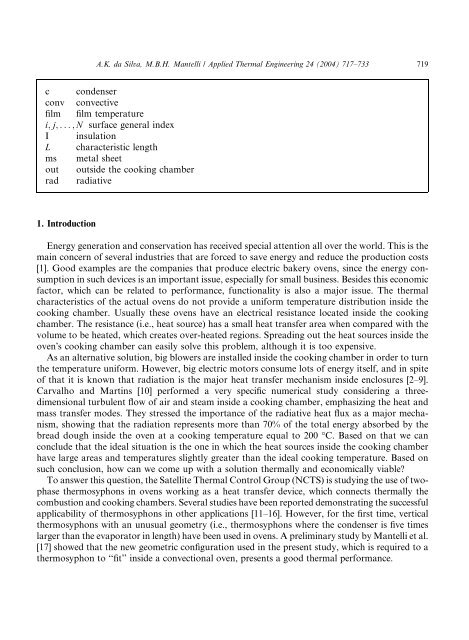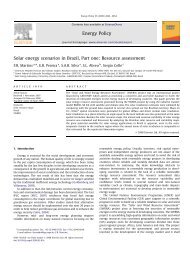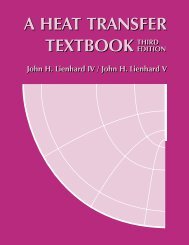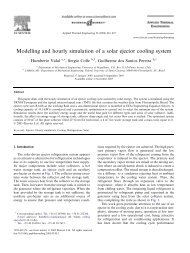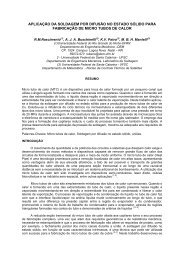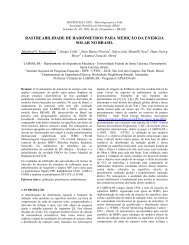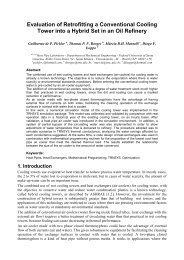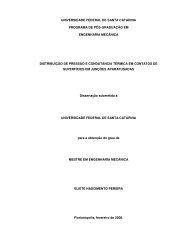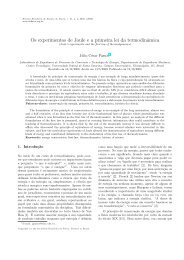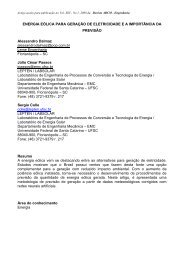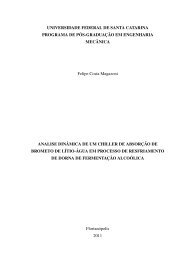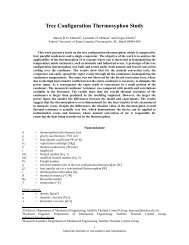Thermal applicability of two-phase thermosyphons in ... - LEPTEN
Thermal applicability of two-phase thermosyphons in ... - LEPTEN
Thermal applicability of two-phase thermosyphons in ... - LEPTEN
You also want an ePaper? Increase the reach of your titles
YUMPU automatically turns print PDFs into web optimized ePapers that Google loves.
A.K. da Silva, M.B.H. Mantelli / Applied <strong>Thermal</strong> Eng<strong>in</strong>eer<strong>in</strong>g 24 (2004) 717–733 719c condenserconv convectivefilm film temperaturei; j; ...; N surface general <strong>in</strong>dexI <strong>in</strong>sulationL characteristic lengthms metal sheetout outside the cook<strong>in</strong>g chamberrad radiative1. IntroductionEnergy generation and conservation has received special attention all over the world. This is thema<strong>in</strong> concern <strong>of</strong> several <strong>in</strong>dustries that are forced to save energy and reduce the production costs[1]. Good examples are the companies that produce electric bakery ovens, s<strong>in</strong>ce the energy consumption<strong>in</strong> such devices is an important issue, especially for small bus<strong>in</strong>ess. Besides this economicfactor, which can be related to performance, functionality is also a major issue. The thermalcharacteristics <strong>of</strong> the actual ovens do not provide a uniform temperature distribution <strong>in</strong>side thecook<strong>in</strong>g chamber. Usually these ovens have an electrical resistance located <strong>in</strong>side the cook<strong>in</strong>gchamber. The resistance (i.e., heat source) has a small heat transfer area when compared with thevolume to be heated, which creates over-heated regions. Spread<strong>in</strong>g out the heat sources <strong>in</strong>side theovenÕs cook<strong>in</strong>g chamber can easily solve this problem, although it is too expensive.As an alternative solution, big blowers are <strong>in</strong>stalled <strong>in</strong>side the cook<strong>in</strong>g chamber <strong>in</strong> order to turnthe temperature uniform. However, big electric motors consume lots <strong>of</strong> energy itself, and <strong>in</strong> spite<strong>of</strong> that it is known that radiation is the major heat transfer mechanism <strong>in</strong>side enclosures [2–9].Carvalho and Mart<strong>in</strong>s [10] performed a very specific numerical study consider<strong>in</strong>g a threedimensionalturbulent flow <strong>of</strong> air and steam <strong>in</strong>side a cook<strong>in</strong>g chamber, emphasiz<strong>in</strong>g the heat andmass transfer modes. They stressed the importance <strong>of</strong> the radiative heat flux as a major mechanism,show<strong>in</strong>g that the radiation represents more than 70% <strong>of</strong> the total energy absorbed by thebread dough <strong>in</strong>side the oven at a cook<strong>in</strong>g temperature equal to 200 °C. Based on that we canconclude that the ideal situation is the one <strong>in</strong> which the heat sources <strong>in</strong>side the cook<strong>in</strong>g chamberhave large areas and temperatures slightly greater than the ideal cook<strong>in</strong>g temperature. Based onsuch conclusion, how can we come up with a solution thermally and economically viable?To answer this question, the Satellite <strong>Thermal</strong> Control Group (NCTS) is study<strong>in</strong>g the use <strong>of</strong> <strong>two</strong><strong>phase</strong><strong>thermosyphons</strong> <strong>in</strong> ovens work<strong>in</strong>g as a heat transfer device, which connects thermally thecombustion and cook<strong>in</strong>g chambers. Several studies have been reported demonstrat<strong>in</strong>g the successful<strong>applicability</strong> <strong>of</strong> <strong>thermosyphons</strong> <strong>in</strong> other applications [11–16]. However, for the first time, vertical<strong>thermosyphons</strong> with an unusual geometry (i.e., <strong>thermosyphons</strong> where the condenser is five timeslarger than the evaporator <strong>in</strong> length) have been used <strong>in</strong> ovens. A prelim<strong>in</strong>ary study by Mantelli et al.[17] showed that the new geometric configuration used <strong>in</strong> the present study, which is required to athermosyphon to ‘‘fit’’ <strong>in</strong>side a convectional oven, presents a good thermal performance.


